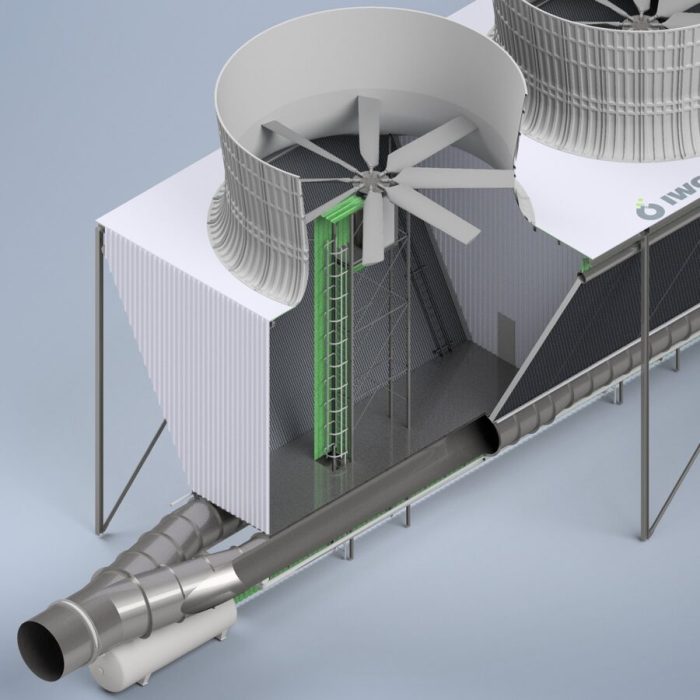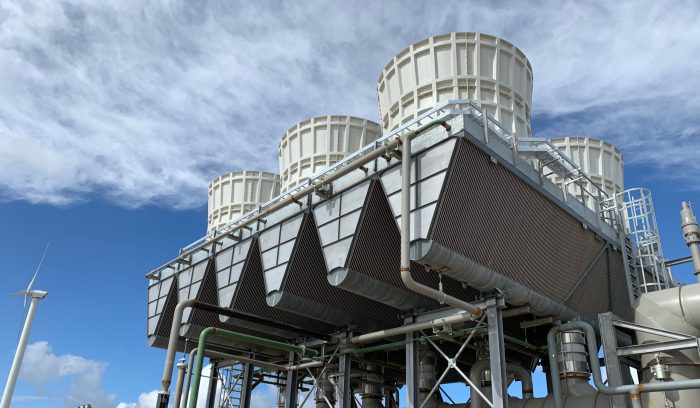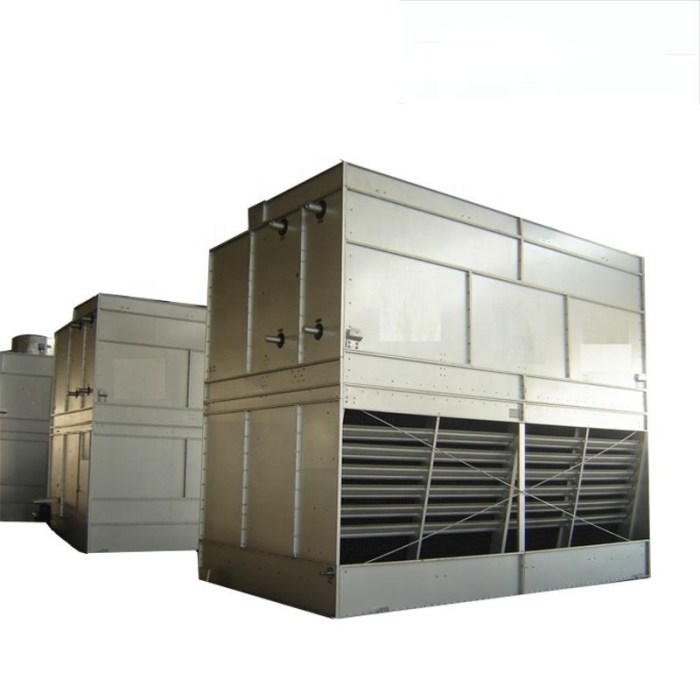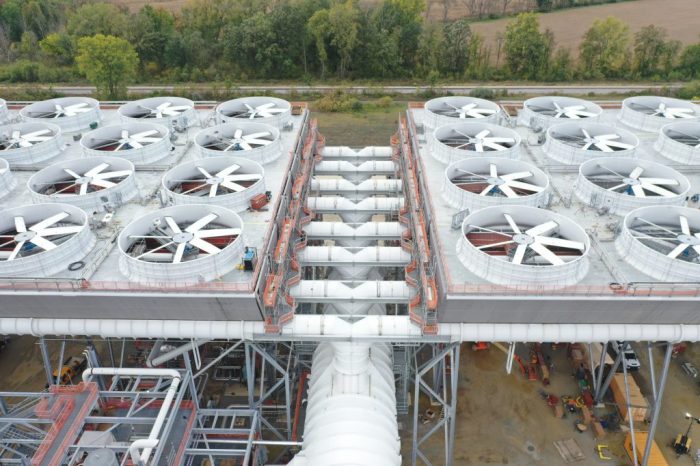An induced draft air cooled condenser (IDACC) stands as a pivotal component in cooling systems, offering a compelling solution for heat dissipation. Its design and operation hinge on a meticulous understanding of airflow patterns and heat transfer processes, making it an indispensable tool in various industrial applications.
Delving into the intricacies of an IDACC, this article explores its components, design considerations, performance analysis, and practical applications. Moreover, it delves into maintenance procedures and troubleshooting techniques, ensuring optimal operation and longevity.
Definition and Overview

An induced draft air cooled condenser (IDACC) is a type of heat exchanger that utilizes the principles of thermodynamics to remove heat from a working fluid. It is commonly employed in industrial cooling systems, particularly in power plants and other facilities that generate substantial amounts of heat.
IDACCs function by inducing airflow through a series of finned tubes containing the working fluid. The airflow is generated by a fan located at the discharge end of the condenser, which draws air through the tubes and over the fins.
As the air passes over the fins, it absorbs heat from the working fluid, causing it to cool down. The cooled air is then discharged into the atmosphere, while the cooled working fluid is returned to the system for further use.
Purpose and Significance
IDACCs play a crucial role in cooling systems by maintaining the desired temperature of the working fluid. This is essential for ensuring efficient operation of the system and preventing damage to equipment. IDACCs are particularly well-suited for applications where large amounts of heat need to be dissipated, such as in power plants and industrial processes.
Components and Operation: An Induced Draft Air Cooled Condenser

An induced draft air cooled condenser (IDACC) is a type of condenser used in power plants to condense steam from a turbine into water. It consists of several key components that work together to achieve efficient heat transfer and condensation.
The main components of an IDACC include the condenser tubes, fins, fan, and casing. The condenser tubes are typically made of copper or aluminum and are arranged in a vertical or horizontal orientation. Fins are attached to the tubes to increase the surface area for heat transfer.
The fan is located at the top of the condenser and draws air through the condenser, creating a flow of air over the tubes. The casing encloses the condenser and directs the airflow.
Airflow Pattern and Heat Transfer
The airflow pattern in an IDACC is designed to maximize heat transfer between the steam and the cooling air. The air is drawn into the condenser by the fan and flows over the condenser tubes. As the air flows over the tubes, it absorbs heat from the steam, causing the steam to condense into water.
The condensed water is then collected at the bottom of the condenser and pumped out.
Design Considerations

The design of an IDACC is influenced by various factors, including ambient temperature, fan performance, and tube geometry.
Ambient temperature affects the heat transfer rate and the required fan capacity. Higher ambient temperatures reduce the heat transfer rate, necessitating larger fans or more fan power to maintain the desired cooling capacity.
Fan Performance, An induced draft air cooled condenser
Fan performance is crucial for IDACC efficiency. The fan must provide sufficient airflow to remove the heat from the condenser tubes. Fan performance is affected by factors such as fan speed, blade design, and motor efficiency. Proper fan selection ensures optimal airflow and energy efficiency.
Tube Geometry
The tube geometry, including tube diameter, tube length, and tube spacing, influences the heat transfer rate and pressure drop. Larger tube diameters and shorter tube lengths promote heat transfer, while wider tube spacing reduces pressure drop. The optimal tube geometry balances these factors to achieve the desired cooling performance and efficiency.
Performance Analysis
Performance evaluation of induced draft air cooled condensers (IDACCs) is crucial to ensure optimal cooling and energy efficiency. Several metrics are used to assess their performance, including heat transfer efficiency and pressure drop.
Heat transfer efficiency measures the ability of the IDACC to transfer heat from the refrigerant to the ambient air. It is typically expressed as a percentage and calculated based on the temperature difference between the refrigerant and the air, as well as the heat transfer area.
Pressure Drop
Pressure drop refers to the decrease in pressure as air flows through the IDACC. Excessive pressure drop can lead to reduced airflow and decreased cooling capacity. It is calculated by measuring the pressure difference between the inlet and outlet of the condenser.
Applications and Benefits

Induced Draft Air Cooled Condensers (IDACCs) find widespread applications in various industries due to their ability to provide efficient and reliable cooling in a compact footprint.
The advantages of using IDACCs compared to other cooling methods include:
- Compact size:IDACCs require less space than evaporative cooling towers, making them suitable for installations with limited space.
- Lower water consumption:IDACCs do not require water for evaporation, resulting in significant water savings compared to wet cooling systems.
- Reduced maintenance:IDACCs have fewer moving parts than evaporative cooling towers, reducing maintenance requirements and costs.
- Increased reliability:IDACCs are less susceptible to fouling and corrosion, ensuring reliable operation over a longer period.
However, IDACCs also have some limitations:
- Higher energy consumption:IDACCs require more energy to operate than evaporative cooling towers due to the use of fans for air circulation.
- Increased noise levels:IDACCs can generate higher noise levels than evaporative cooling towers, which may require additional noise mitigation measures.
- Lower efficiency at high ambient temperatures:The performance of IDACCs decreases at higher ambient temperatures, as the cooling capacity is affected by the reduced temperature difference between the condenser and the ambient air.
Maintenance and Troubleshooting

Maintaining IDACCs involves regular inspections, cleaning, and servicing to ensure optimal performance and longevity. Troubleshooting common issues during operation is essential to minimize downtime and maintain efficiency.
Maintenance Procedures
- Regularly inspect fan blades, motor, and bearings for any signs of wear, damage, or corrosion.
- Clean condenser coils and fins periodically to remove dirt, debris, and other contaminants that can impede heat transfer.
- Check refrigerant levels and pressure to ensure proper operation and identify any leaks.
- Lubricate moving parts as per manufacturer’s recommendations to reduce friction and wear.
- Monitor operating parameters such as temperature, pressure, and flow rate to identify any deviations from normal conditions.
Troubleshooting Tips
- Reduced cooling capacity:Check refrigerant levels, clean condenser coils, inspect fan operation, and ensure proper airflow.
- Increased energy consumption:Inspect fan motor, check for any mechanical issues, and optimize fan speed.
- Noise and vibration:Inspect fan blades, motor, and bearings for any damage or misalignment.
- Condensation or frosting:Check refrigerant levels, ensure proper airflow, and inspect for any leaks.
- High discharge pressure:Check condenser coils for cleanliness, inspect fan operation, and ensure adequate airflow.
Case Studies and Examples

Induced Draft Air Cooled Condensers (IDACCs) have been successfully implemented in various industrial and commercial applications. Here are some case studies and examples that demonstrate their effectiveness and benefits:
Example 1: Power Plant Retrofit
- A power plant in the Middle East upgraded its existing cooling system with an IDACC.
- The IDACC significantly reduced water consumption, lowering operating costs and environmental impact.
- The plant experienced increased efficiency and reliability due to the improved cooling performance.
Example 2: Data Center Cooling
- A large data center in the United States installed an IDACC to meet its demanding cooling requirements.
- The IDACC provided efficient and reliable cooling, ensuring optimal performance of the servers.
- The data center achieved significant energy savings and reduced its carbon footprint.
Example 3: Industrial Process Cooling
- A manufacturing plant in Europe utilized an IDACC to cool process fluids in a high-temperature application.
- The IDACC effectively dissipated heat, improving process efficiency and product quality.
- The plant realized cost savings through reduced maintenance and downtime.
Challenges and Lessons Learned
- Proper design and sizing are crucial for optimal performance.
- Airflow management and fan selection are critical to ensure efficient cooling.
- Regular maintenance and inspections are essential for long-term reliability.
- Adequate space and infrastructure are required for installation and operation.
FAQ Corner
What is the primary function of an IDACC?
An IDACC’s primary function is to dissipate heat from a cooling system by utilizing airflow to cool down a condenser.
What are the key factors influencing the design of an IDACC?
Ambient temperature, fan performance, and tube geometry are crucial factors that impact the design of an IDACC.
How is the performance of an IDACC evaluated?
Performance metrics such as heat transfer efficiency and pressure drop are commonly used to evaluate the performance of an IDACC.